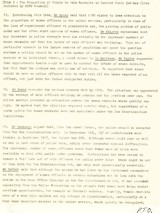Equality and Gender in the Police Service
Legislation in the early 1970s insisted that there was to be no discrimination between men and women at the workplace. This presented problems for some people in those institutions or workplaces where an understanding of distinct and different gender roles had meant that different tasks were entrusted to men and women.
There were no women police officers in the United Kingdom until the First World War when they were established, in small numbers, principally to supervise women working in munitions factories and to keep young women away from large army camps. They survived into the post-war world facing much hostility from male police who considered that policing was ‘men’s work’ because it could be dangerous.
For the first two thirds of the twentieth century most women officers were directed to focus their attention purely on what were considered to be ‘women’s matters’ – that is duties and jobs that women were expected to deal with in a separate female sphere of life. Essentially this meant that they looked after women and children in trouble or in danger. The equal opportunities legislation required that men and women be entrusted with the same tasks at the workplace. It was no longer possible to describe some aspects of policing as ‘men’s work’ and other aspects as ‘women’s work.’
Documents
- Two photographs of women police officers c. 1919: marching to duty and a Superintendent with her junior officers.
- Discussion at the Chief Constables' Central Conference, 3rd November 1977, about the role of women police officers and the validity of the Sex Discrimination Act 1975.
- Letter from the Equal Opportunities Commission concerning the use of women police officers for riot control duties, 6th February 1979.
- Reply by the Chief Constable of West Midlands Police, 27th April 1979.
- Further letter from the Equal Opportunities Commission regarding the role of women police officers, 29th August 1979.
- Covering letter from the West Midlands Police to ACPO accompanying above correspondence.
- A photograph of a modern woman police officer.
- A letter from the Royal Commission on Equal Pay to Chief Constables seeking their comments on the question of equal pay for women police officers.
Note
It may be important to get the students to understand here how attitudes have changed since this legislation has bedded down. Police officers worrying about women being 'weaker' was probably typical of perception in the early 1970s and it would be quite wrong to criticize senior officers as old-fashioned blimps for expressing these concerns amongst themselves during this period.
Equality and Gender
